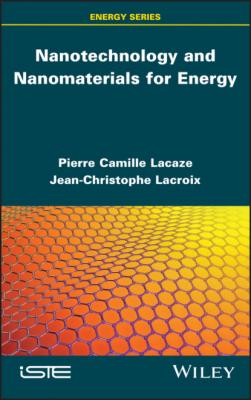Nanotechnology and Nanomaterials for Energy. Pierre-Camille Lacaze
Читать онлайн.| Название | Nanotechnology and Nanomaterials for Energy |
|---|---|
| Автор произведения | Pierre-Camille Lacaze |
| Жанр | Физика |
| Серия | |
| Издательство | Физика |
| Год выпуска | 0 |
| isbn | 9781119881575 |
Table of Contents
1 Cover
4 Introduction I.1. History of nanotechnology I.2. Outline of this book I.3. Dedication
5 PART 1 Nanomaterials and Nanotechnologies 1 Carbon-based Nanomaterials 1.1. Fullerenes 1.2. Carbon nanodiamonds 1.3. Carbon dots or carbon quantum dots 1.4. Carbon nanotubes 1.5. Graphene 1.6. Graphene quantum dots 1.7. Conclusions and perspectives of carbon-based nanomaterials 2 Inorganic Nanomaterials 2.1. Metallic nanoparticles 2.2. Metal nanoclusters 2.3. Semiconductor quantum dots 2.4. Two-dimensional inorganic lamellar nanosheets 2.5. Hybrid metal-organic frameworks 2.6. Conclusions on inorganic nanomaterials
6 PART 2 Nanotechnology and Nanomaterials for Energy 3 Energy Storage 3.1. Worldwide energy use 3.2. Energy storage systems 3.3. Conclusions on energy storage 4 Energy Conversion 4.1. Photovoltaics 4.2. Electroluminescence, lighting and display 4.3. Conclusions on energy conversion 5 Electro- and Photocatalysis 5.1. Water splitting 5.2. Electrolysis techniques 5.3. HER and OER processes in water splitting 5.4. Photoelectrochemical water splitting 5.5. Fuel cells
9 Index
Guide
1 Cover
9 Index
List of Illustrations
1 Chapter 1Figure 1.1. Number of publications on the subject of fullerenes, CNTs and graphe...Figure 1.2. Fullerenes: C60 (a) and C70 (b)Figure 1.3. Voltametric curves showing redox of C60 in a low temperature acetoni...Figure 1.4. Structure of two carboxyfullerene stereoisomers, C3-C60 and D3-C60. ...Figure 1.5. Structure of the C80 fullerene and of the ECF Sc3N@C80. a) C80 fulle...Figure 1.6. Progressive transformation of nanodiamonds (ND) into OLF. a) Beginni...Figure 1.7. Simplified diagram showing the detonation technique for nanodiamond ...Figure 1.8. Fluorescence of ND nanocrystallites containing NV defectsFigure 1.9. Structure of carbon quantum dots (CQD) showing the association of gr...Figure 1.10. Luminescence of an aqueous solution of CQDs produced by laser ablat...Figure 1.11. Luminescence of CQDs deposited on a glass substrateFigure 1.12. Simplified diagram of the CVD apparatus used to produce CNTs. Adapt...Figure 1.13. Schematic illustration of the electrolysis setup for CNT productionFigure 1.14. Diagram showing the formation of an SWCNT defined by rolling up a g...Figure 1.15. Examples of different CNT configurations. a) Examples of two SWCNTs...Figure 1.16. Different steps in CNT growth using the VSS mechanismFigure 1.17. Characterization of SWCNTs synthesized using different catalysts (m...Figure 1.18. Illustration of CNT growth from cycloparaphenylene (CPP). a) Armcha...Figure 1.19. Separation of SWCNTs of structure (n,m) using ultracentrifugation, ...Figure 1.20. Diagram of a “composite” electrode, made up of a “forest” of SWCNTs...Figure 1.21. Horizontally aligned SWCNT array on silicon substrateFigure 1.22. SWCNT “forest” deposited vertically on a silicon substrateFigure 1.23. Graphene films deposited on a Si substrate covered with a thin laye...Figure 1.24. Resistivity variations of graphene and two 2D materials as a functi...Figure 1.25. Resistivity of graphene and
